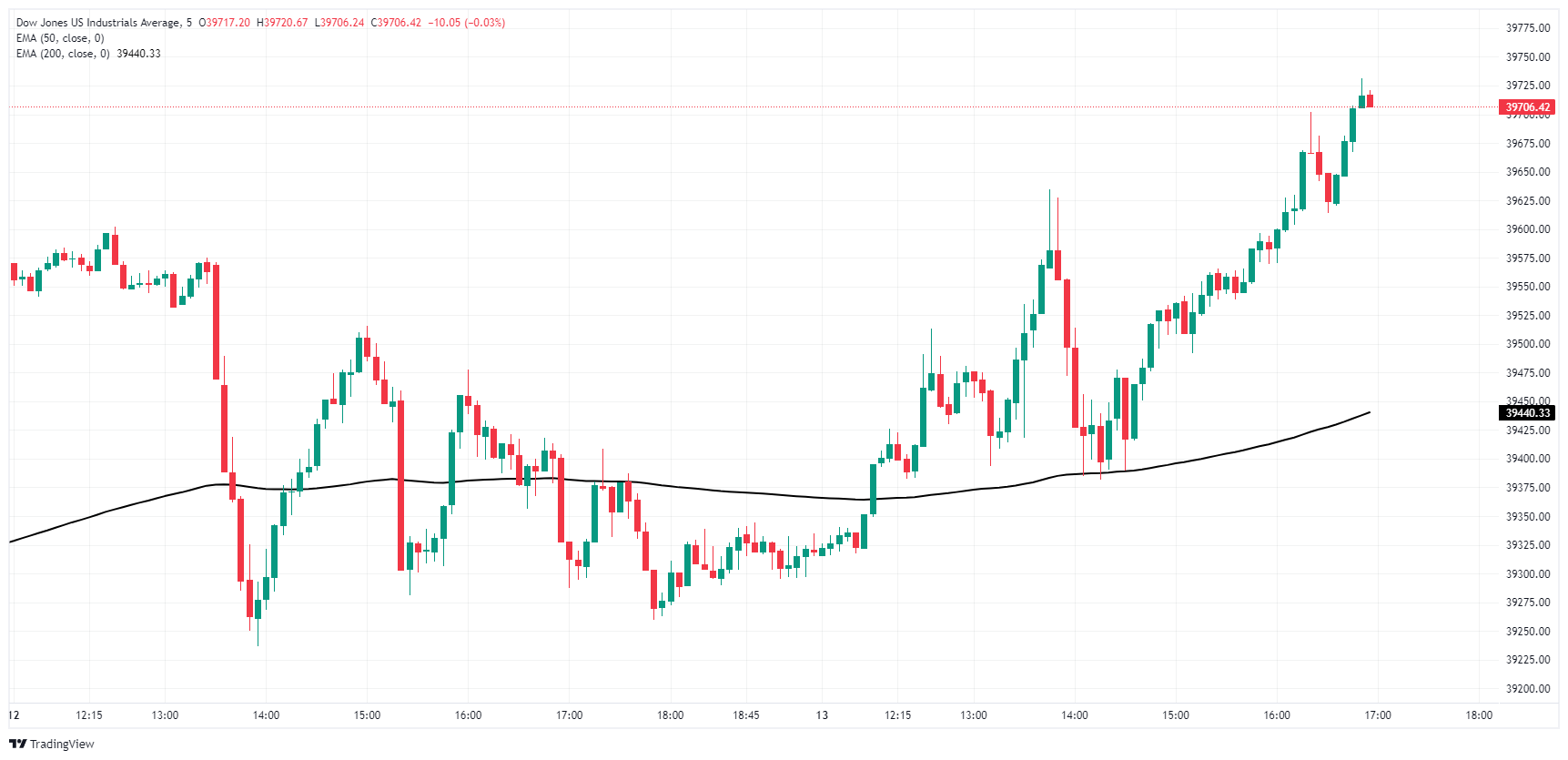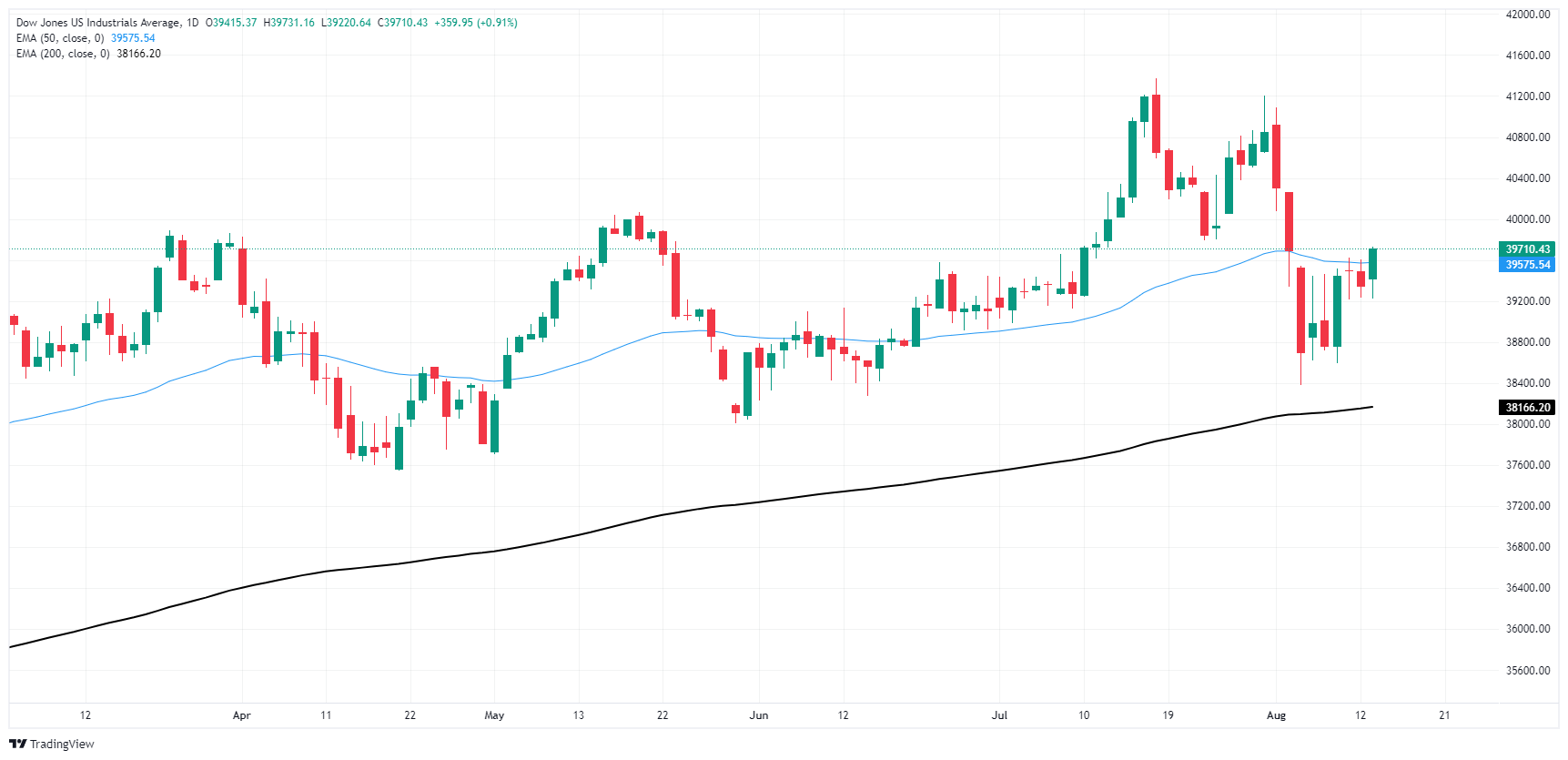Dow Jones Industrial Average recovers ground on cooling PPI inflation
- Dow Jones rallied 300 points in choppy trading on Tuesday.
- Equities found higher ground on Tuesday as US inflation pressures ease.
- After cooling PPI print, US CPI inflation remains in the barrel for Wednesday.
The Dow Jones Industrial Average (DJIA) found the gas pedal on Tuesday, rising 300 points after US Producer Price Index (PPI) inflation eased more than expected in July. This gave stocks a chance to breathe and sent the DJIA into 39,700.00.
Stock news: The Home Depot scores another healthy quarter despite weakness among US consumers
US PPI inflation eased to 2.2% YoY in July, falling below the expected 2.3% and declining even further from the previous period’s revised 2.7%. Core PPI inflation also declined to 2.4% for the year ended in July, dropping below the forecast 2.7% and falling well below the previous 3.0%. Continued declines in US inflation pressure bolstered risk appetite in the US market session, and market bets of a 50 basis point double-cut in September from the Federal Reserve (Fed) rose to 55%, according to the CME’s FedWatch Tool.
US Consumer Price Index (CPI) inflation is the week’s key data print, slated for Wednesday. Core CPI inflation is forecast to tick down to 3.2% YoY from 3.3%. Markets have fully priced in at least a quarter-point cut from the Fed on September 18, and continued easing in inflation metrics will likely spark a further dogpile into bets of a double cut.
Dow Jones news
All but five of the Dow Jones’ constituent securities were in the green on Tuesday, with Walmart Inc. (WMT) falling -1.25% to $67.80 per share ahead of the retail giant’s latest earnings report slated for August 15.
Nike Inc. (NKE) rallied 5.6% on Tuesday to $78.83 per share as the shoe manufacturer sees a rebound in its share price on what investors are calling “brand momentum” following a shuffle of downstream production chains and new franchise shoe releases garnering significant search interest. Nike recently suffered a harsh blow after poorer-than-expected fiscal quarter performance which sent the stock tumbling from valuations above $90.00 per share.
Dow Jones price forecast
Tuesday’s Dow Jones rally dragged the major equity index into a one-week high on approach to 39,800.00 as bidders attempt to reclaim the 40,000.00 major price handle. The Dow Jones recently tumbled to its lowest prices in weeks near 38,400.00 after getting knocked off of all-time highs near 41,400.00.
The DJIA is trading back above the 50-day Exponential Moving Average (EMA) for the first time since tumbling below the technical average in early August. Long-run trends still lean in favor of buyers, with the index continuing to trade on the north side of the 200-day EMA at 38,166.00.
Dow Jones five-minute chart
Dow Jones daily chart
Dow Jones FAQs
The Dow Jones Industrial Average, one of the oldest stock market indices in the world, is compiled of the 30 most traded stocks in the US. The index is price-weighted rather than weighted by capitalization. It is calculated by summing the prices of the constituent stocks and dividing them by a factor, currently 0.152. The index was founded by Charles Dow, who also founded the Wall Street Journal. In later years it has been criticized for not being broadly representative enough because it only tracks 30 conglomerates, unlike broader indices such as the S&P 500.
Many different factors drive the Dow Jones Industrial Average (DJIA). The aggregate performance of the component companies revealed in quarterly company earnings reports is the main one. US and global macroeconomic data also contributes as it impacts on investor sentiment. The level of interest rates, set by the Federal Reserve (Fed), also influences the DJIA as it affects the cost of credit, on which many corporations are heavily reliant. Therefore, inflation can be a major driver as well as other metrics which impact the Fed decisions.
Dow Theory is a method for identifying the primary trend of the stock market developed by Charles Dow. A key step is to compare the direction of the Dow Jones Industrial Average (DJIA) and the Dow Jones Transportation Average (DJTA) and only follow trends where both are moving in the same direction. Volume is a confirmatory criteria. The theory uses elements of peak and trough analysis. Dow’s theory posits three trend phases: accumulation, when smart money starts buying or selling; public participation, when the wider public joins in; and distribution, when the smart money exits.
There are a number of ways to trade the DJIA. One is to use ETFs which allow investors to trade the DJIA as a single security, rather than having to buy shares in all 30 constituent companies. A leading example is the SPDR Dow Jones Industrial Average ETF (DIA). DJIA futures contracts enable traders to speculate on the future value of the index and Options provide the right, but not the obligation, to buy or sell the index at a predetermined price in the future. Mutual funds enable investors to buy a share of a diversified portfolio of DJIA stocks thus providing exposure to the overall index.
